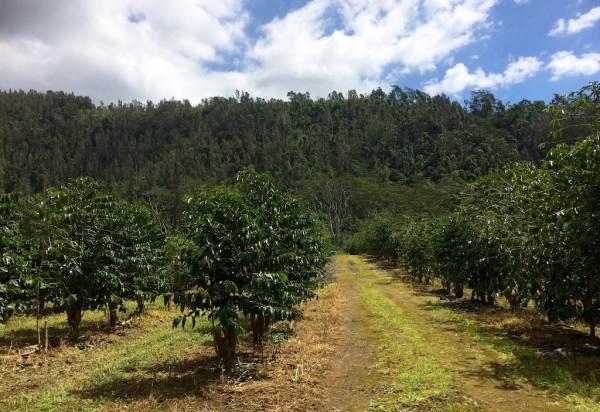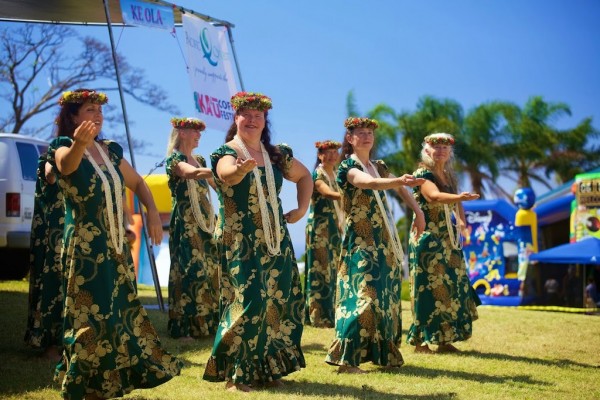Having been in coffee for more than 13 years, I am a tad embarrassed to admit that I have never been to the United States’ main coffee origin: Hawaii. I haven’t even been to its famous beaches, let alone its inland coffee farms. Sad, right?
So when a few weeks ago I was invited to be a speaker at the Ka’u Coffee Festival‘s “Coffee College,” I jumped at the chance. The trip gave me the wonderful experience of visiting Hawaii and seeing first-hand how coffee is grown in Ka’u. Just as awesome, I finally got to visit my long-term friends’ coffee farm, Rusty’s Hawaiian.
The Ka’u Coffee Festival’s 7th Annual Ho’olaule’a was held at the Pahala Community Center and featured a full day of free entertainment with performers coming from as far away as Japan, Ka’u coffee tastings, prize raffles and crafts and food offered by a range of vendors. Particularly delightful were hula performances by Halau Hula Kalehuaki’eki’eika’iu, Hannah’s Makana ‘Ohana Hula Halau and Halau Hula O Leionalani, combined with live music and fresh, local food.
But for us coffee geeks, the real local flavor came from a full day of coffee tastings. The festival brought in baristas and other coffee pros from all over the Hawaiian islands, as well as the mainland United States, for preparation and service. The tasting itself was a bit of a whirlwind — the program included 11 rounds, each round featuring a single coffee prepared with seven different brewing methods (Hario V60, Chemex, Aeropress, Kalita Wave, French Press, flash-brewed iced Chemex, and espresso.)
It was a spectacular way to experience these coffees direct from Ka’u farmers, and provided an enlightening crash course for many on brew method and flavor. Most exciting to me were the reactions of the farmers as they tried their coffees from each of the brew methods. The typical reaction was incredulity, even disbelief that coffee tasting this way indeed was theirs. That is the kind of experience that many of us, as coffee professionals, live for — the dawning of comprehension that coffee is not only a science but also an art, and vice versa, and that every hand that touches it makes meaningful impact.
The next day, my time was spent at Ka’u Coffee College, designed exclusively for the benefit of Ka’u coffee farmers. The presentations were focused on maintaining high quality all the way through to the final cup, a concept that was strengthened from the previous day’s tasting exercises.
Four guest speakers addressed about 60 farmers and some members of their families in a modestly small auditorium. And while the speaking sessions were not designed in collaboration, and covered a wide array of coffee-quality-focused topics, a remarkable synergy among developed between the sessions and the speakers themselves.
The invited speakers were:
- Andrew Hetzel – CafeMakers
- Andrea Kawabata – University of Hawai’i
- myself, Andy Newbom – IPCoffees Specialty
- David Waldman – Rojo’s Roastery
Hetzel led with an in-depth presentation about the many defects that can degrade coffee beans and drag the quality down. His presentation showed examples and explanations of many defects including: full blacks, mold, sour beans, withered beans, immature, broken and chipped beans and insect damage such as the coffee borer beetle. He stressed that all of these defects were detriments to holding onto a reputation for specialty coffee and that most, if not all such defects, could be avoided or cleaned out of the final coffee. He showed examples of how these defects can come from farming, harvesting, processing, transportation and storage methods. He encouraged farmers to frequently cup their own coffee and those of other farmers and coffees from around the world and to learn to detect defects and how to prevent them.
Kawabata also encouraged farmers to focus their efforts on maintaining high quality. “Once you have tarnished your reputation, it is hard to get it back,” she said, urging farmers to also look toward long-term rather than short-term profit. Kawabata’s presentation included the first round of results of a fascinating study done by the University of Hawaii, UCC and several other coffee groups on the “Taste Threshold of Coffee Berry Borer damage in coffee.” (Check back here in the next few weeks for a more in-depth article on this study’s findings.) In short Kawabata suggested coffee berry borer treatments have to be planned extremely carefully. “If Coffee Berry Borer subsidies (funding) don’t come in, spray anyway,” she urged. “If you miss an application you run a substantial risk of irreparably damaging your entire crop.”
For my part, I hit the farmers hard about the tough competition in pricing, with excellent coffee coming from countries where there is cheaper land and less expensive labor than in Hawaii. I encouraged them to stop relying on the “hawaii bikini train” that has delivered high prices regardless of actual coffee value. I admonished them to never give customers what they want — only give them what they do best. In order to do that, they have to decide what they do better than other farms and build a story around that. I stressed the importance in Ka’u building or preserving the highest standards, distinguishing itself from Kona, and sharing the farmers’ stories with coffee drinkers. I attempted to argue that it is not reasonable to think a coffee business can be sustained simply by its place within or near a visitor destination. “You have had it easy,” I told them. “And it’s going to get a hell of a lot harder.”
Waldman talked about the rapidly increasing sophistication of coffee buyers in the high-end specialty market. “There is no fooling people anymore about the quality of coffee,” he told the group. “They will pay high prices for high quality.” He talked about how even as few as ten years ago, his customers didn’t like the citrus flavors of lighter roasts and high altitude coffees, but now many consumers seek out these very qualities. He said customers are increasingly using less milk in their coffee, demonstrating their their desire to actually taste the coffee. He urged farmers to allow buyers to visit them, see the farms and the soil and the trees, and to sit with them to cup coffee. Be open to suggestions, he told them.
The farmers were highly receptive and engaged in all four presentations and had a plethora of questions, as well as input and points of clarification. Ka’u coffee enjoys a global reputation for exceptional quality, in great part because of the highly engaged, hardworking people in that room. Their passion, curiosity and fierce commitment to their coffee was profoundly evident.
One doesn’t have to travel to the beautiful island of Hawaii to taste Ka’u coffees brewed seven ways, although that is now my preferred method. After all, it’s a business expense, right?
Andy Newbom
Andy Newbom has spent the past 18 years working with producers, millers, exporters and importers at origin to improve the quality and profitability of specialty coffee throughout the supply chain. His passion and mission is to bring about a revolution in specialty coffee by improving quality and yields to build a massive market for good and great coffee, and to deliver sustainable prices throughout the coffee chain. Newbom was the co-founder of IPCoffees Specialty Imports, Barefoot Coffee Roasters, Finca Coffees and Brew Revolution Craft Brewery, along with his equally coffee-obsessed wife Nanelle Newbom, and one of the six founders of the Barista Guild of America.
Comment
1 Comment
Comments are closed.











Order green beans from Sweet Maria’s and you’ll never have to worry about roasting what says is Hawaiian but really isn’t….